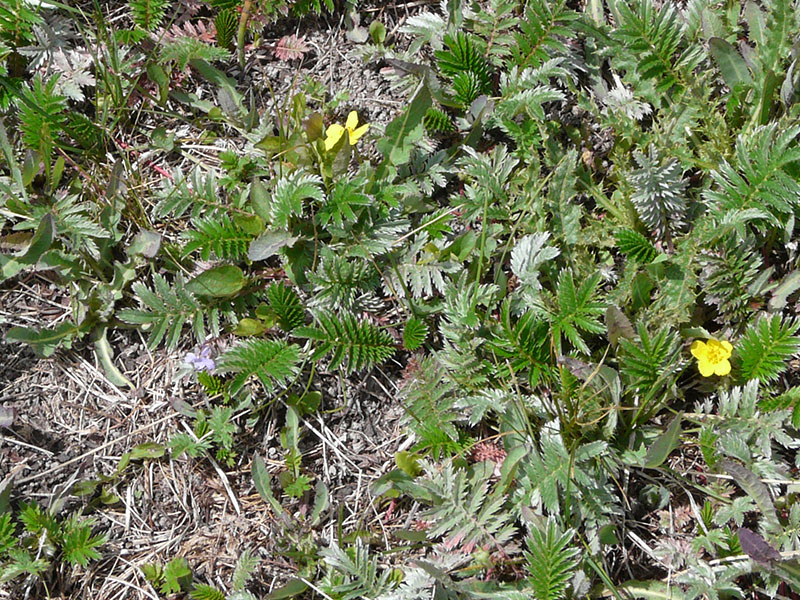Argentina anserina / silverweed
- silvery, compound leaves on low, creeping stems
- yellow, 5+ petaled flowers; lots of stamens
- fens, other wetlands, but also roadsides
Also known as: common silverweed, an seachdamh aran (the seventh bread, Scottish Gaelic), argentine, bread-and-butter, bread and cheese, briosglan/brislean (brittle, Scottish Gaelic), brisgean, crampweed, dog tansy, ewe-daisy, fair days, fern-buttercup, fish-bones, golden flower, golden sovereigns, goose grass, goose tansy, goosewort, mascorns, moon grass, moor grass, moss corns, moss-crop, prince’s feathers, silver feather, silver fern, silver grass, silver leaves silvery cinquefoil, silver-weed, silverweed, swine’s beads, swine’s murriks, swine’s grass, trailing tansy, traveller’s ease, wild agrimony
Synonym: Potentilla anserina (still the “accepted name” in Minnesota)
The common silverweed is a low-growing herbaceous plant with creeping red stolons. It spreads so easily from the stolons, taking root where they touch the soil, that the seeds seem rather superfluous. Silverweed is a short-lived perennial, but older plants do form a taproot which has been historically important as a food item.
From these creeping red stolons arise the basal leaves, ca. 4–8 in. long and pinnately divided. Unlike many leaves of this structure, in silverweed, there are many larger leaflets interspersed with smaller ones. The leaves have 5-11 pairs of paired, opposite leaflets and a sessile terminal leaflet. All the leaflets have saw-toothed edges. The name silverweed comes from the appearance engendered by the dense, silky-white hairs, particularly on the lower surface.
For those interested in the reasons systematists move plants around in their classifications (other than for the fun of it), the doubly-lobed leaves were one excuse to remove this from Potentilla. Another would be the fact that the flowers are single, not in clumps.
The flowers themselves look like those of countless other yellow Rosaceae, to my mind. They are small (<1″ across), produced singly on long, naked pedicels. They have 5-7 yellow petals and enough stamens to convince you this is in the Rosaceae. The pedicels usually put the flowers at some distance from the leaves.
Silverweed basically likes wetter areas – mudflats, back waters, wet meadows, edges of ponds, Woods Creek Fen (and other fens), but it for some reason can also live on roadsides, in disturbed areas, or even on sand dunes.
Overall, this is a very easy plant to identify once you have the search image. But now for…
Some interesting bits
Like mountain ash (rowan), silverweed was putatively good for warding off witches’ spells and evil spirits. More pedantically, it was (and still is?) used as a shoe insert to absorb sweat.
You might have noted the plethora of common names… and these are just the ones in English (and Gaelic). There are also a slew in other languages, especially from lands with historically poor food security. For the ones listed here, my thanks to a delightful writeup on the species by David Watson Hood. All these names are really the result of the plant’s many uses, especially for food, and especially in regions (Scotland, Finland, Tibet) where other food might be (or have been) hard to come by. Hood notes that “the Gaelic name of this plant, “an seachdamh aran” (the seventh bread), shows its economic importance, B.P. (before potatoes).”
So, yes, it is edible, but what does it taste like? Again, from Hood’s notes: “I first tasted silverweed when I was living in Wales…. Although it is said to taste like parsnips, I don’t agree. I think this is the root equivalent of the, “it tastes like chicken”, nonsense remark that people are always making about unusual food animals like hedgehogs. Especially nonsense now most chicken does not even taste like chicken. It tastes like silverweed.” I suppose that means, to find out, you dig up the tap root – in the spring especially – and eat it raw, boiled or roasted. But on the other hand, an extract from the root has also been used to tan leather. Hmm. What did Mom say about putting unknown things in your mouth?
| Color | |
|---|---|
| Family | |
| Blossom size | |
| Inflorescence size | |
| Inflorescence type | |
| When? | |
| Where? | fens, moist meadows, stream banks, wet(ter) meadows, wetlands |

